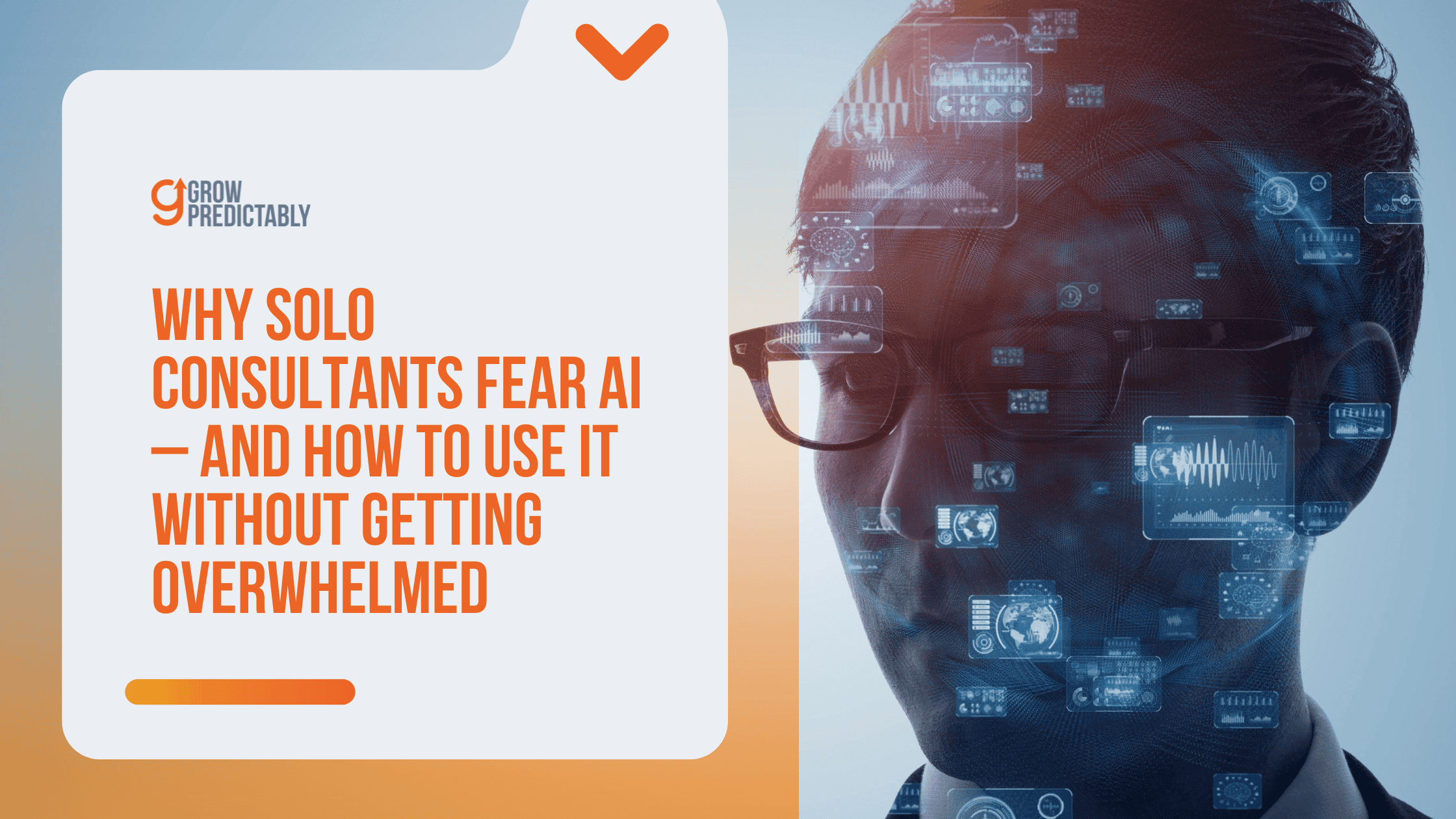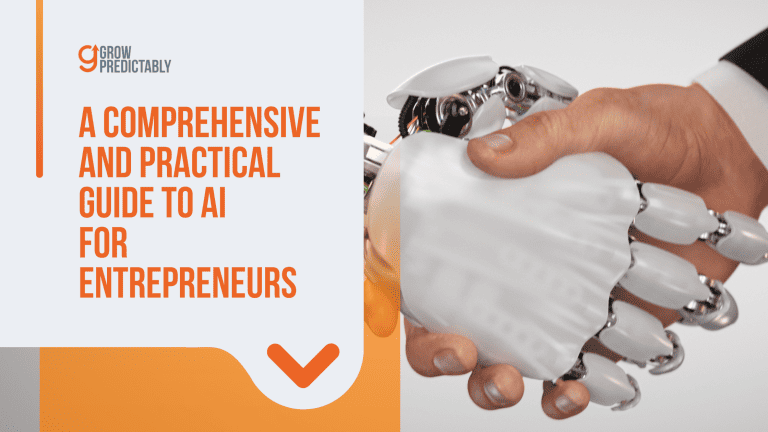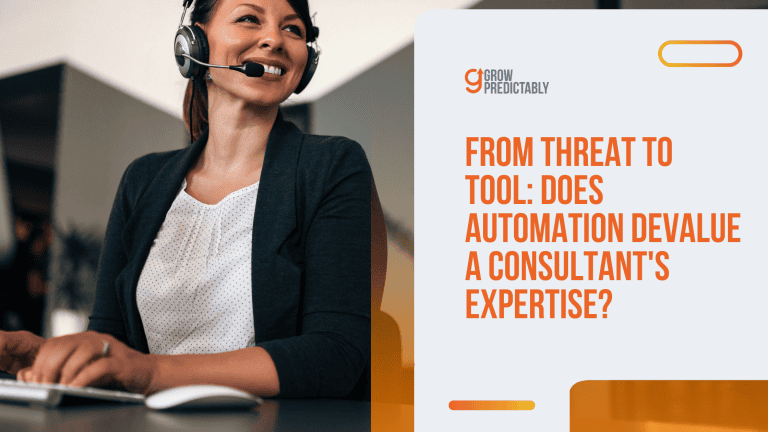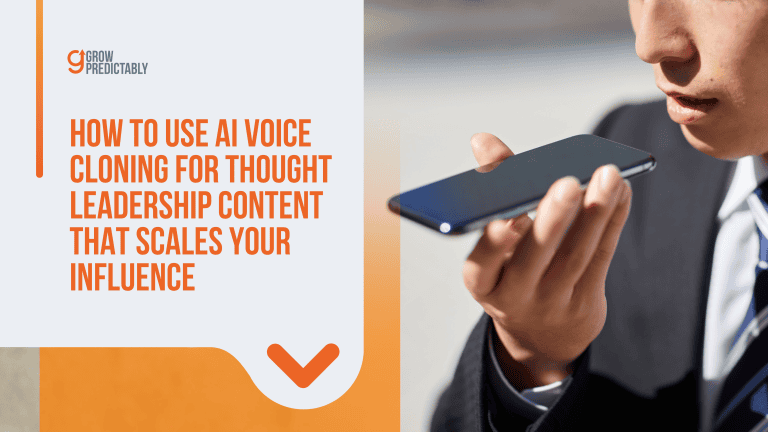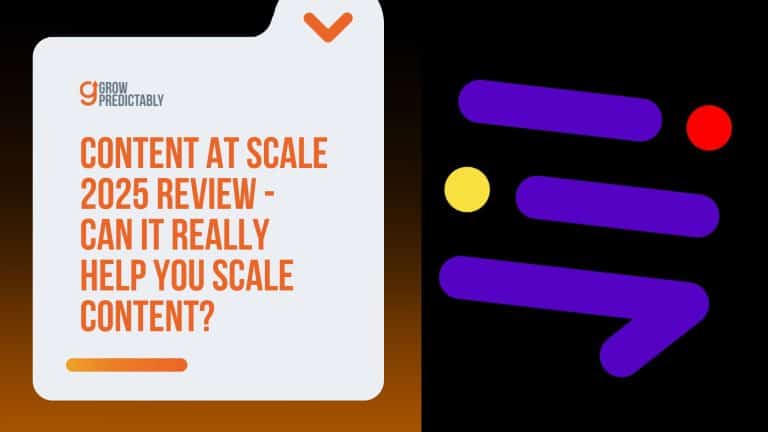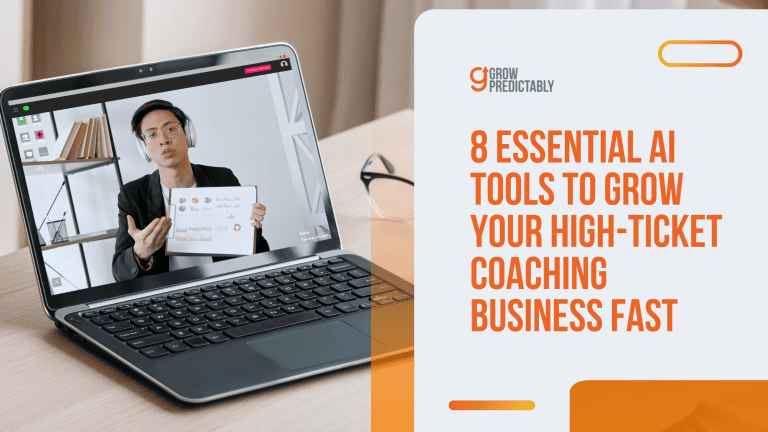Why Solo Consultants Fear AI — And How to Use It Without Getting Overwhelmed
Over 47% of professionals now fear AI could replace their roles within five years, underscoring how technological progress is outpacing human confidence. (Source)
The biggest fears about AI adoption for solo consultants—from job displacement and data privacy to decision paralysis—reflect a deeper tension between autonomy and survival in a market that rewards adaptation.
The irony?
Avoiding AI often undermines the very independence consultants value most. The solution isn’t resisting intelligent tools but refining how you use them.
By integrating AI in targeted, workflow-specific ways, solo consultants can gain greater strategic control—freeing time for creativity, insight, and higher-value client relationships.
At Grow Predictably, we apply a structured, evidence-based approach that helps consultants translate AI anxiety into measurable growth and sustainable advantage, without losing their personal edge.
Here’s how strategic adoption turns anxiety into an advantage.
TL;DR
Solo consultants face unique challenges with AI adoption, such as fears of job displacement, data privacy, skill gaps, and maintaining client trust. However, by strategically approaching these fears, consultants can leverage AI as a tool for enhancement, efficiency, and competitive advantage.
KEY TAKEAWAYS
- Redefine your value proposition by positioning yourself as an AI-enhanced consultant, focusing on strategic thinking and client relationships.
- Develop privacy protocols and use enterprise-level tools to safeguard client information, ensuring trust and professionalism.
- Break AI learning into small, manageable steps and establish clear ethical guidelines to integrate AI while maintaining transparency and trust with clients.
Why is AI Adoption a Unique Challenge for Solo Consultants?
You’re not alone in feeling pulled in two directions about AI.
As a solo consultant—whether you’re a freelance copywriter crafting compelling stories, an executive coach guiding leaders, a fractional CMO driving marketing strategy, or an independent HR consultant shaping workplace culture—you face a unique set of pressures when it comes to new technology.
Unlike professionals in larger organizations, you’re both the CEO making strategic decisions AND the person who has to implement AI adoption.
There’s no team to delegate the learning curve of implementing AI solutions, no IT department to handle the setup, and no buffer if something goes wrong.
You’re like a lone captain navigating the sea of AI tools, with your reputation and livelihood tied directly to the choices you make.
Why Do Solo Consultants Feel Extra Pressure?
What makes your situation different is that everything falls on your shoulders.
When you’re considering AI adoption, you’re not just thinking about efficiency—you’re weighing real concerns.
- Will clients think I’m cutting corners if I use AI models?
- What if I invest time learning AI solutions that quickly become outdated?
- How do I maintain the personal touch that sets me apart?
- If I don’t adopt AI, will competitors who do leave me behind?
These aren’t just passing worries—they’re tied to your identity as a professional and your ability to earn a living.
According to recent data, 62% of users feel increased pressure to perform due to the rapid work impact of data collection by AI systems. (Source)
What’s The Reason Behind Why Solo Consultants Fear AI?
Behind the practical concerns lie deeper emotional triggers:
- Fear of obsolescence: “If AI can do part of my job, what happens to my value?”
- Decision fatigue: “With so many tools and so little guidance, how do I even start?”
- Authenticity concerns: “Will my work still feel like ‘me’ if AI is involved?”
- Isolation in decision-making: “I have no colleagues to compare notes with—am I making the right choice?”
Based on an original research, data reveals self-employed workers experience greater techno-complexity and techno-privacy stress compared to professionals working in teams and groups. (Source)
You truly are facing a unique challenge.
Why This Matters Right Now
92% of professions today require digital and tech-savviness according to the National Skills Coalition, with approximately 33% of talents lacking basic skills. (Source)
Clients are beginning to expect faster turnarounds, more innovative approaches, and competitive pricing—all things AI adoption can help deliver.
At the same time, they still want the personal expertise and relationship, supported by AI solutions, that only you can provide.
We’re at a tipping point.
With basic AI literacy, the need to adopt AI is clear, and finding the balance isn’t optional anymore.
What Makes Your Journey Different
Unlike professionals in larger agencies, you face a triple threat of risks:
- Financial risk: Every dollar and hour you invest comes directly from your pocket
- Reputation risk: There’s no brand buffer between you and potential AI mishaps
- Ethical responsibility: You alone must ensure client data and trust are protected
But here’s the good news—these unique challenges also create unique opportunities for solo consultants who navigate them thoughtfully.
In the sections that follow, we’ll explore five core fears in depth and give you practical, real-world tools to transform each into a strength.
You’ll discover how to regain clarity, confidence, and control over AI—without compromising the trust-based business you’ve worked so hard to build.
The path forward isn’t about replacing your expertise with technology.
It’s about finding the sweet spot where AI solutions amplify your unique human skills, giving you more time to focus on what truly matters: the relationships and insights that no algorithm can replicate.
What Biggest Fears Do Solo Consultants Have About AI Adoption?
What if the very thing you’re afraid of—AI—could become your best assistant?
As a solo consultant, you’re facing these decisions alone.
No IT department to guide you, no team to share the learning curve with—just you making high-stakes choices about AI adoption in technology that’s evolving at lightning speed.
Let’s walk through the five biggest fears I’ve seen solo consultants face when considering AI tools.
Each one is real and valid—but each also contains seeds of opportunity in change management when approached thoughtfully.
1. Fear of Job Displacement
When your entire business revolves around your expertise and billable hours, any threat, including an AI agent, to that model hits at your very livelihood.
The worry that AI might replace your core services isn’t just professional—it’s personal.
Amidst various AI initiatives, according to a study by McKinsey and another one from Microsoft, a considerable number of professionals worry AI could replace at least some portion of their current service offerings. (1,2)

Job Displacement → Using AI to Boost Your Strategic Value
When you’re a solo consultant, your expertise is your livelihood.
Highlighting business value, the thought of AI replicating what you do can feel like watching your business model crumble.
How to Overcome:
- Redefine your value proposition — Position yourself as an “AI-enhanced consultant” rather than competing with AI models by implementing AI efficiently. Your human experience, judgment, and relationship skills are irreplaceable.
- Use AI for the routine, shine in the strategic — Let AI handle data analysis, research summaries, and initial drafts while you focus on high-value strategic thinking and client relationships.
- Document your AI-human workflow — Create a one-page visual showing clients how you use AI to enhance (not replace) your thinking process.
Start experimenting with AI as an enhancement to your work, not a replacement.
Use it for first drafts or research, then apply your unique expertise to elevate the output.
Track which parts of your workflow benefit most from AI assistance versus which aspects truly require your human touch.
Your specialized knowledge and client relationships remain your greatest assets—AI simply lets you deliver them more efficiently.
How It Increases Strategic Value
When you offload routine tasks to an AI agent, you gain 30-40% more time for deep strategic work that clients truly value.
One executive coach reported doubling her client strategy sessions after implementing an AI agent for note-taking and follow-up emails.
What’s one repetitive task that drains your energy each week? For those who resist AI adoption, how might delegating it to AI free you to do more of what you love?
2. Data Privacy and Security Concerns
Solo consultants often work with sensitive client information.
Without a security team backing you up, one privacy mistake could damage your reputation permanently.
AI technologies help address this concern.
According to Glide’s 2025 ‘State of AI in Operations,’ half of the businesses surveyed cite data privacy and security concerns as their top barrier to AI adoption amongst numerous AI initiatives. (Source)
Data Security Concerns → Shaping AI for Data Privacy
Client confidentiality isn’t optional—it’s fundamental to your business.
One data breach could permanently damage trust you’ve spent years building.
How to Overcome:
- Create a “sensitive information protocol” — Develop clear guidelines for responsible AI use defining what types of information never go into an AI agent (client names, proprietary data, etc.).
- Choose enterprise-level tools when handling sensitive data — Many AI platforms offer business tiers with enhanced security features and data handling agreements.
- Be transparent with clients — Develop a simple one-pager explaining your AI usage policies and privacy safeguards.
Start with a personal data policy—even a simple one-pager outlining which tools you use, what data goes where, and how you protect client information.
Research each AI tool’s privacy terms before using it, and consider premium versions with stronger privacy protections for client work.
Taking clear, documented steps to protect data doesn’t just reduce risk—it demonstrates your professionalism and care for client interests.
How It Preserves Your Reputation
By proactively addressing privacy concerns, you position yourself as a thoughtful, ethical professional.
Several consultants report that their privacy protocols actually become selling points when pitching to security-conscious clients.
What specific client information do you handle that requires the highest level of protection? Write down your three non-negotiable privacy rules.
3. Cost of Technology and ROI Uncertainty
Every dollar you spend comes directly from your pocket.
Without a corporate budget backing you, investing in AI tools feels risky—especially when you can’t predict the return.
Enterprise-wise AI initiatives achieved an ROI of just 5.9% while incurring a 10% capital investment, according to IBM Institute for Business Value. (Source)
Tech ROI Uncertainty → AI Pays for Itself
Every dollar matters when you’re running a solo practice, and investing in new technology without guaranteed returns feels risky.
How to Overcome:
- Start with free or low-cost options — Begin with tools like ChatGPT’s free tier to test use cases before committing to paid versions.
- Track time savings rigorously — Document exactly how much time AI saves you on specific tasks for two weeks (e.g., “First draft writing: 2 hours → 40 minutes”).
- Calculate your “AI ROI” — Multiply time saved by your hourly rate, then subtract tool costs.
Many consultants find their tools pay for themselves within weeks.
To help determine adoption ROI, there are simple measures that you can do.
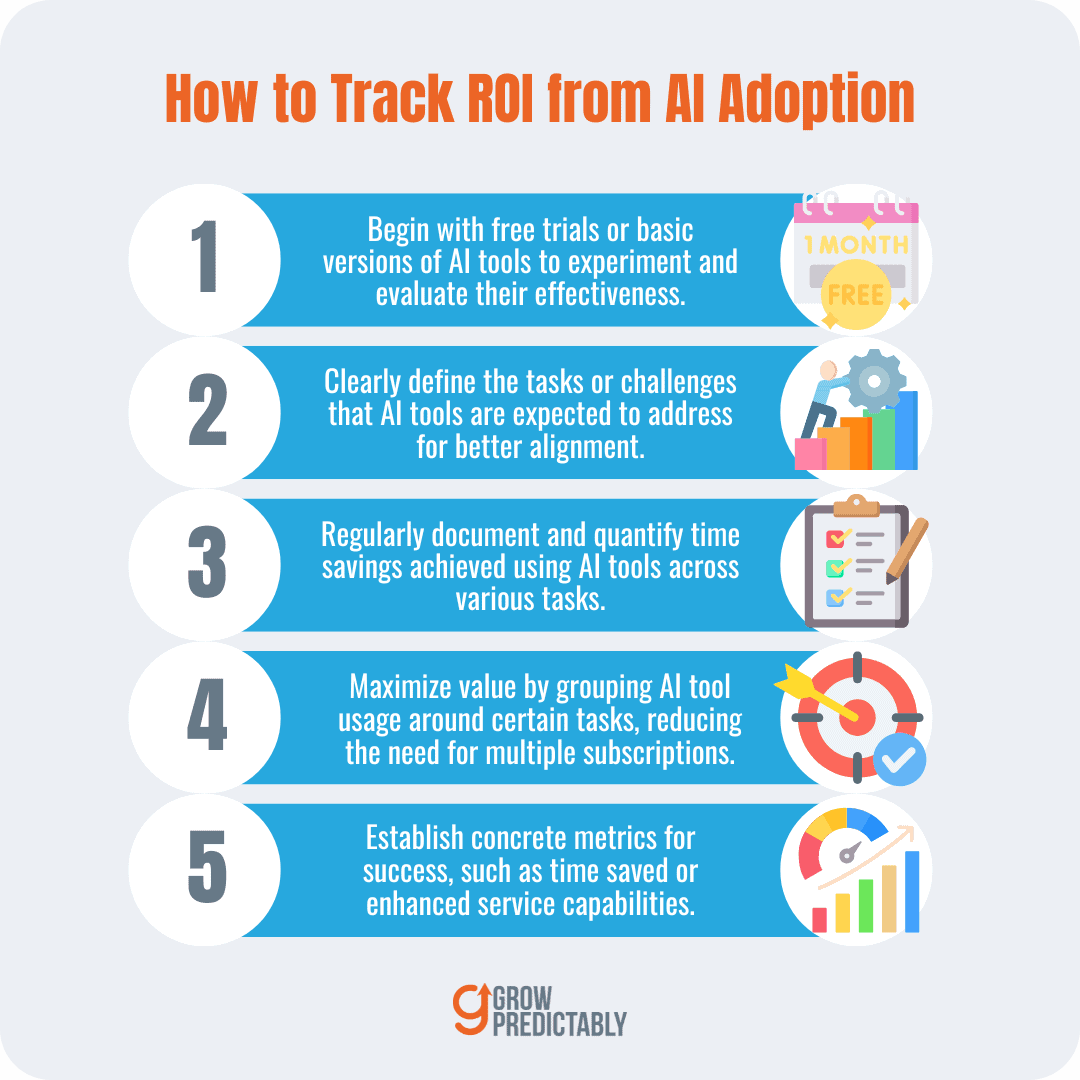
Start with free tiers to test tools before committing financially.
Set specific metrics to track before adopting any paid tool—whether that’s time saved, output increased, or new services enabled.
Consider batching your AI usage to maximize value from fewer tools rather than subscribing to many.
The right AI investment should pay for itself through either time savings or new revenue opportunities—but only if you approach it strategically.
How It Pays for Itself
A freelance copywriter tracked her productivity and found that a $20/month AI writing assistant saved her 12 hours monthly—translating to $1,800 in potential additional revenue at her current rates.
If you could reclaim 5 hours each week, would you use that time to serve more clients or improve your work-life balance? Business leaders often face this choice too. What would that be worth to you?
4. Skill Gap and Overwhelm with Complexity
Learning new technology takes precious time away from client work and business development.
The constant feeling of “falling behind” creates anxiety that can paralyze decision-making.
61% of full-time professionals feel overwhelmed by the rapid development of AI, according to the Henley Business School report. (Source)
Additionally, 60% of workers say they’d be more likely to use AI at work if proper training were available.
Skill Gap → Building Confidence with AI
Learning new technology while managing client work can feel impossible.
The fear of falling behind creates anxiety, while the complexity of AI tools can be intimidating.
Hence the necessity of acquiring AI skills.
How to Overcome:
- Adopt the “15 minute rule” — Dedicate just 15 minutes daily to learning one AI skill. Small, consistent efforts compound quickly.
- Focus on use-case mastery, not tool mastery — Instead of trying to learn everything about an AI tool, perfect one specific workflow that directly benefits your business.
- Join a peer learning group — Find other solo consultants learning AI (through platforms like Circle or Facebook Groups) and share prompts, use cases and wins.
Focus on mastering just one AI tool that aligns with your most time-consuming task.
Dedicate 30 minutes twice weekly to learning and practice.
Join communities of similar professionals to share prompts and workflows rather than creating everything from scratch.
Remember that even partial implementation can yield significant benefits—perfection isn’t required to start seeing returns on your learning investment.
How It Builds Confidence
By breaking AI adoption into small, manageable steps, you transform overwhelm into a series of small wins.
One marketing consultant shared that after mastering just three AI workflows, she began advertising “AI-enhanced services” as a premium offering, thereby demonstrating clear business value.
What’s one small, specific AI skill that would make an immediate difference in your work this week? How can you carve out 15 minutes to learn it?
5. Ethical Implications and Client Trust
Your personal brand and client relationships are built on trust.
Using AI raises questions about originality, disclosure, and authenticity that could undermine that foundation.
In one Salesforce resource, citations reveal how the increasing use of AI adoption in businesses across different countries impacts the trust consumers have over how AI is used in the services they avail. (Source)

Ethical Implications → Championing Trust and Transparency with AI
Your reputation is built on authenticity and trust.
Using AI without proper disclosure could undermine client relationships if they feel misled.
How to Overcome:
- Develop an “AI disclosure framework” — Create clear guidelines for responsible AI usage defining when and how you’ll disclose AI usage to clients (e.g., “AI-assisted first drafts, human-refined final product”).
- Position AI as a client benefit — Frame your AI usage in terms of how it benefits clients: faster turnaround times, more comprehensive research, or cost efficiencies.
- Establish ethical boundaries — Decide what work you’ll never delegate to AI, and communicate these principles to clients.
Decide where AI fits in your workflow, what requires disclosure, and where you draw the line.
Consider creating a transparent “How I Work” document that positions your AI models usage as a benefit to clients rather than a secret.
When approached thoughtfully, ethical AI usage can actually strengthen client relationships by demonstrating your commitment to both innovation and integrity.
How It Deepens Transparency
By proactively addressing ethical considerations, you demonstrate integrity that strengthens client trust.
Several consultants report that transparent AI discussions actually lead to deeper client conversations about process and value.
How would you explain your AI usage to your most important client in a way that highlights the benefits to them? For those who resist AI adoption, develop a simple ethical framework for your practice.
The path to overcoming these fears isn’t about eliminating them completely—it’s about transforming them into guideposts for thoughtful adoption.
In the next section, we’ll explore practical strategies, including change management, to turn each of these challenges into competitive advantages that strengthen your consulting practice.
Your Next Steps: From Fear to Action
The path from AI hesitation to confidently implementing AI doesn’t happen overnight.
Start with these three simple actions:
- Choose one fear from above that resonates most strongly with you
- Implement one strategy from that section this week
- Document the result — what changed in your confidence level or workflow?
Remember, you don’t need to become an AI expert overnight.
The goal isn’t perfection—it’s progress.
Each small step builds momentum that transforms uncertainty into confidence.
Imagine how different your practice could feel three months from now when these fears have transformed into strengths that set you apart from competitors still stuck in hesitation.
The tools and resources in our next section will give you concrete starting points to put these AI adoption strategies into action right away.
Case Study: How AI Acquisition Helped Steven 3x Annual Revenue

In a crowded market of professional services, Steven found himself struggling to differentiate and grow his consultancy business.
Facing competition and scalability issues, he turned to AI to redefine his approach, leading to impressive revenue growth and a more efficient business model.
This case study highlights Steven’s strategic transformation, offering valuable insights into leveraging niche specialization and cutting-edge technology for explosive growth.
Problem
Steven’s consultancy was stuck in a saturated market, offering generic services that blended in with a myriad of competitors.
This posed a significant challenge in standing out and securing premium pricing.
While the business remained profitable, growth was tethered to Steven’s personal input, revealing a desperate need for scalability.
Recognizing the potential of AI, Steven sought a clear framework to harness its power effectively, aiming to position a new offering that stood out in the market and translated into tangible client results.
Solution
- Niche and ICP Definition: Steven received guidance through a structured process that defined a specific niche and Ideal Client Profile (ICP), allowing him to target and acquire clients with precision.
- Value Proposition Reframing: By shifting the conversation from services to high-value outcomes, Steven dramatically shortened the sales cycle, showcasing an immediate ROI to his clients and aligning with their core interests.
- End-to-End System & Tools: He was equipped with a comprehensive set of tools and a scalable business model, which leveraged his technological background to develop a pioneering AI offering.
Results
- Exponential Revenue Growth: In a mere three months, Steven’s annual revenue skyrocketed from a $250k/year run rate to approximately $750k/year.
- High-Ticket Deals: Successfully secured deals with considerable setup fees ranging from $5,000 to $15,000, justified by the immense value delivered.
- Team and Business Scalability: The new model enabled Steven to expand his team with a Virtual Assistant and two sales representatives, promoting growth without increasing his personal workload.
Steven’s journey underscores the transformative potential of AI and niche specialization in the business landscape.
By focusing on a distinct client profile and reframing value propositions, businesses can significantly enhance their growth trajectory.
The integration of AI not only differentiates offerings but facilitates a scalable operational model that supports innovation and delegation.
This case exemplifies how adaptability and strategic focus can drive substantial success, illustrating the dynamic synergy between modern technology and targeted business solutions.
What AI Tools and Resources Should Solo Consultants Leverage?
There is a workaround to fight the AI fears you have as a solo consultant.
Here are practical tools that reduce the risk while enhancing your credibility, not compromising it.
I’m excited to share these resources. They’ve been tested specifically for solo consultants like you!
| Tool | Cost | Ease of Use (1-5) | Main Functions | Privacy Certifications | Solo Fit Score |
|---|---|---|---|---|---|
| ChatGPT | Free tier; Plus $20/mo | 4 | Content generation, brainstorming, editing, summarizing | SOC 2 Type 2 | 4.5/5 |
| Jasper | Starts $39/mo; 7-day trial | 3.5 | Marketing copy, blog posts, social content, brand voice training | SOC 2, GDPR compliant | 3.5/5 |
| Calendly | Free tier; $12-20/mo | 5 | Scheduling, booking, reminder automation | SOC 2, GDPR, CCPA | 5/5 |
| Claude | Free tier; $20/mo | 4.5 | Nuanced content, research assistant, longer context | SOC 2, Privacy Shield | 4/5 |
| Paperbell | $57/mo; 30-day trial | 4 | Client management, scheduling, payments for coaches | GDPR compliant | 4.5/5 |
| Notion AI | $10/mo add-on to Notion | 3.5 | Note summarization, idea expansion, knowledge management | SOC 2 Type 2, GDPR | 4/5 |
- ChatGPT: Perfect first AI tool! Helps you draft content while maintaining your voice. Great for getting unstuck on projects.
- Claude: Handles nuanced, sensitive topics better than most AI tools. Excellent for client-facing materials that need emotional intelligence.
- Calendly: The ultimate time-saver that pays for itself in the first week by eliminating scheduling back-and-forth.
- Notion AI: Turns your personal knowledge base into a searchable second brain. Fantastic for systematizing your expertise.
Sample Workflows to Try This Week
ChatGPT Quick-Start Workflow
- Draft client proposal outlines (saves 30+ minutes per proposal)
- Run through a voice-check prompt: “Rewrite this in my authentic voice, which is [insert 3 adjectives about your style]”
- Review and personalize before sending
Calendly + Email Integration Workflow
- Set up discovery call slots that respect your energy levels
- Connect to personalized email snippets that go out automatically
- Include pre-call questions that gather key client information
Claude Research Assistant Workflow
- Upload industry reports or competitor materials (within privacy guidelines)
- Ask for key insights, trends, and opportunities
- Use findings to enhance your strategic recommendations
What Not to Do
- Privacy Alert: Don’t input confidential client data into free AI versions. Most have data retention policies that could compromise privacy.
- Quality Check: Never send AI-generated content directly to clients without your review. AI can hallucinate facts and miss nuances only you understand.
- Over-automation: Don’t automate personal touchpoints that build relationships. Use AI for prep work, not client interaction.
How to Get Started Today
Pick just ONE tool from this list to try this week.
Start small with this 3-step warmup:
- Choose a repeatable task that takes you at least 20 minutes each week
- Create a simple prompt to help the AI understand what you need
- Review and refine the output, noting what works and what doesn’t
Remember, the goal isn’t to replace your expertise. It’s to adopt AI to amplify it.
These tools work best when they handle the routine tasks so you can focus on the high-value work only you can do.
FAQs
Embracing Change—With Confidence and Clarity
To recap, adopting AI as a solo consultant means navigating worries about obsolescence, data protection, investments, learning curves, and client trust.
But each concern can be flipped into an advantage: boosting your strategic value, deepening transparency, and ultimately making your consultancy more competitive.
It’s natural to feel overwhelmed—but you’re uniquely positioned to adapt quickly, test tools that really fit, and build closer client relationships. Your courage and transparency inspire others in the field.
Take action today: pick one practical step or tool suggested here, and let us know how it shapes your work.
Need more support? Check out our expanded guides and community forums for solo consultants in the resource links.
What would be possible for your business if you let AI handle the routine, so you could focus completely on the work—and people—that matter?
What’s one barrier you want to overcome right now?
You’re part of a broader movement redefining the value of “solo”—showing that technology and humanity are most powerful together.
Let’s lead the way, thoughtfully and boldly.

